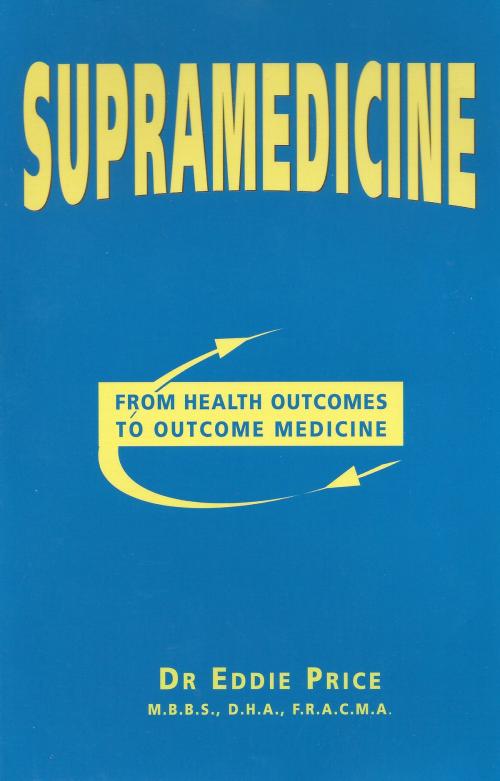SUPRAMEDICINE
From Health Outcomes to Outcome Medicine
Nonfiction, Health & Well Being, Medical, Reference, Administration, Patient Care, Health Care Delivery| Author: | Dr Eddie Price | ISBN: | 9781925271355 |
| Publisher: | Australian eBook Publisher | Publication: | April 22, 2015 |
| Imprint: | Language: | English |
| Author: | Dr Eddie Price |
| ISBN: | 9781925271355 |
| Publisher: | Australian eBook Publisher |
| Publication: | April 22, 2015 |
| Imprint: | |
| Language: | English |
Over the years from 1985 to 1997, there were significant developments in the Health Outcomes movement, as well as in science with the development of “Systems Theory”.Systems Theory became modern science by 1997 and was now no longer viewing nature as separate objects or things, but as a hierarchy of interdependent systems.Nature is divided into a hierarchy of systems, above and below the individual. All of these systems influence the individual and the individual’s health. Those above the individual, in hierarchical order, are communities, family, and the person’s environment, nutrition and behaviours.Systems below the individual human body, in top down order are, the cardiovascular, neurological, respiration, etc systems, organs, tissues and cells. These are known as subsystems.This highlights that there are systems above the human body, called Suprasystems.Dr Price, by applying Systems Theory to human health, pointed out that current medicine almost exclusively dealt with the subsystems of the human body.By 1997, excellent validated and reliable patient-reported questionnaires, known as Health Outcomes, were being used in research at the individual patient level to measure a person’s functional health status or “Health-Related Quality of Life” (HRQoL).Some of these quantified questionnaires were more accurate than blood pressure measurement.There were many thousands of excellent generic (general health) as well as body part-specific measures.Dr Price realised that the techniques used to achieve valid and reliable measures for HRQoL could now be used to measure the individual’s health systems “above the human body” - the “SUPRA” systems.This would include “measures of family/community support and the person’s interrelationship with the health system”.This was previously termed as “relieving distress”.In this book, it is now defined as “A person’s confidence that care and comfort is available in times of illness”.It would also include measures of a person’s diet, environment, behaviours, e.g. smoking and alcohol; and i.e. their risk factors or their lack of preventive and health promotive behaviours and interrelationships.These are all suprasystems or systems above the individual that can now be measured in each individual patient.In utilising these tools in his own preventive occupational health practice, Dr Price realised these were really a new set of Diagnostic Tools. These in turn would lead to a new set of lifestyle functional treatments that should have revolutionised, and still will revolutionise, medicine.Hence the title and sub-title “Supramedicine. From Health Outcomes to Outcomes Medicine”.
Over the years from 1985 to 1997, there were significant developments in the Health Outcomes movement, as well as in science with the development of “Systems Theory”.Systems Theory became modern science by 1997 and was now no longer viewing nature as separate objects or things, but as a hierarchy of interdependent systems.Nature is divided into a hierarchy of systems, above and below the individual. All of these systems influence the individual and the individual’s health. Those above the individual, in hierarchical order, are communities, family, and the person’s environment, nutrition and behaviours.Systems below the individual human body, in top down order are, the cardiovascular, neurological, respiration, etc systems, organs, tissues and cells. These are known as subsystems.This highlights that there are systems above the human body, called Suprasystems.Dr Price, by applying Systems Theory to human health, pointed out that current medicine almost exclusively dealt with the subsystems of the human body.By 1997, excellent validated and reliable patient-reported questionnaires, known as Health Outcomes, were being used in research at the individual patient level to measure a person’s functional health status or “Health-Related Quality of Life” (HRQoL).Some of these quantified questionnaires were more accurate than blood pressure measurement.There were many thousands of excellent generic (general health) as well as body part-specific measures.Dr Price realised that the techniques used to achieve valid and reliable measures for HRQoL could now be used to measure the individual’s health systems “above the human body” - the “SUPRA” systems.This would include “measures of family/community support and the person’s interrelationship with the health system”.This was previously termed as “relieving distress”.In this book, it is now defined as “A person’s confidence that care and comfort is available in times of illness”.It would also include measures of a person’s diet, environment, behaviours, e.g. smoking and alcohol; and i.e. their risk factors or their lack of preventive and health promotive behaviours and interrelationships.These are all suprasystems or systems above the individual that can now be measured in each individual patient.In utilising these tools in his own preventive occupational health practice, Dr Price realised these were really a new set of Diagnostic Tools. These in turn would lead to a new set of lifestyle functional treatments that should have revolutionised, and still will revolutionise, medicine.Hence the title and sub-title “Supramedicine. From Health Outcomes to Outcomes Medicine”.















